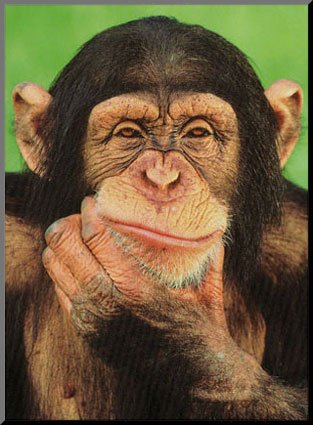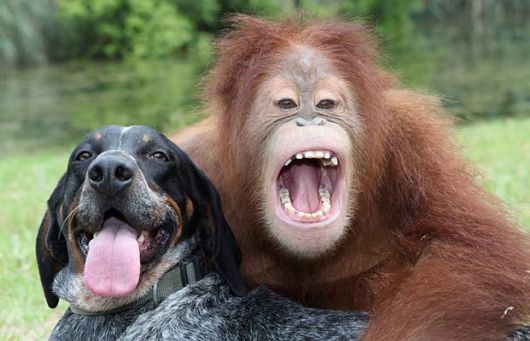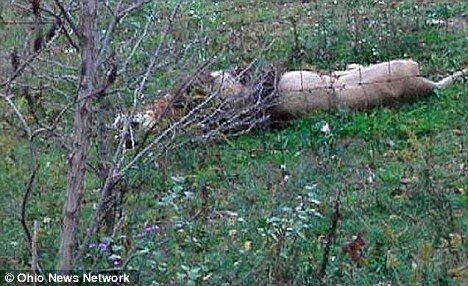Researchers have found that chimpanzees and orangutans really do have personalities “like people”.
For years experts have debated whether great apes truly display human-like personalities – or if such behavior is simply the anthropomorphic projections of human observers.
The research team used a statistical technique to “remove” any biases apparent in human observers of the apes’ behavior, and they say their findings suggest man and ape really do share “personality dimensions”.
“[Chimpanzees] have the same social problems that we do, they want to make friends and find mates and sort of gain position within their society,” says team member Mark Adams, a researcher who conducted the research while studying for his PhD at the University of Edinburgh, UK.
Dr. Alexander Weiss, senior lecturer at the University of Edinburgh, who also worked on the study, agrees that chimpanzee personality is “highly similar” to that of humans.
Researchers categorize human personality into five “dimensions”, sometimes known as “the big five”, he explains.
“Those dimensions are neuroticism, extroversion, openness to experience, agreeableness and conscientiousness.”
Previous studies into non-human primates suggest that chimpanzees (Pan troglodytes) share these five dimensions with people, whilst orangutans (Pongo pygmaeus and Pongo abelii) display three of the five: extraversion, neuroticism and agreeableness.
These shared personality dimensions are best explained by our genetic similarities, says Dr. Alexander Weiss.
“Humans and chimps share a common ancestor about 4 to 6 million years ago.”

Researchers have found that chimpanzees and orangutans really do have personalities "like people"
The common ancestor for humans and orangutans is thought to have existed fifteen million years ago, which explains why chimpanzees and humans are more similar in personality than orangutans and humans, says Dr. Alexander Weiss.
There is continuing debate amongst experts as to whether scientists should use anthropomorphic projections when studying how animals behave.
Dr. Clive Wynne, professor of psychology at the University of Florida, Gainesville, US describes anthropomorphism as “a mistake” when “trying to understand animal behavior.”
“Human beings have a very natural tendency to project human agency into almost anything that moves,” he says.
“It’s very deeply ingrained into our ways of trying to understand the world around us.”
But despite our inevitable “human perspective” in the way we see the animal kingdom, he says, “since these animals are not us, although it is difficult, we should nonetheless struggle to get our own perspective out of the way and to try and see them for themselves.”
The research team carrying out the study, which features in the journal Animal Behaviour, wanted to test the extent to which human observers of chimpanzee and orangutan behavior might be biased in their reports.
“There’s sort of a fear that human observers and ‘raters’ are projecting their own ideas about personality on to these animals,” says Mark Adams.
But until now, this theory “hasn’t actually really been tested in great apes.”
Members of the research team – who also came from from Kyoto University in Japan and the University of Arizona, Tucson, US – issued questionnaires to around 230 people observing chimpanzees and orangutans in zoos and research centres in the US, Canada, Australia and Japan.
The survey described about 40 to 50 personality “items”, which when grouped together makes personality dimensions.
The human observers – called “raters” – were instructed to rate the apes’ behavior on a one-to-seven point scale for each personality item.
From the questionnaire results, the team determined the type of biases present in the raters’ observations of the animals.
“We used a statistical technique to remove these observer differences before extracting personality traits from the data,” explains Mark Adams.
“What we found is that controlling for these differences among observers made no difference, which suggests that the observers are not projecting their own ideas about personality onto the animals.”
Dr. Alexander Weiss says that the research “vindicates both the view that chimpanzees have personalities and perhaps the more controversial statement that their personalities are quite similar to those of humans.”
• Common chimpanzees (Pan troglodytes) share 98% of human genes and are mankind’s closest living relative. They are thought to be the most intelligent non-human animal
• Chimpanzees are known to modify sticks, rocks and leaves into “tools” to help the gather food such as ants, nuts and honey
• Orangutans are divided into two species: Bornean orangutans (Pongo pygmaeus) and Sumatran orangutans (Pongo abelii)
• The word orangutan translates as “people of the forest”
• They are also capable of learning to use “tools” such as sticks to gather termites. This knowledge is then passed down through the generations
What is “animal personality”?
• Individual animals display different personalities across a range of species, including mammals, fish, birds, insects and molluscs
• These personality traits control whether individual animals are leaders or followers, bold or shy, aggressive or passive, for example. As with people, some animal’s personalities change as they age
• Great tits look for partners that are as outgoing as themselves, while zebra finches with similar personalities make better parents
• Some fallow deer are braver than others, spending less time looking out for predators and being more likely to try new foods
• A fish’s personality may determine how likely it is to be captured – with bold fish more likely to be hooked
Experts found that although chimps may be known as the brains of the animal kingdom, sometimes only dogs get the point.
Scientists pointed at one of two objects, asked for it to be brought to them, and counted up how many times their orders were obeyed.
In the study, the dogs did better than the chimps, despite the chimpanzee’s brain being the more similar to the human brain.
The research team, from the Max Planck Institute in Leipzig, Germany, placed pairs of similar-looking objects, such as a piece of hosepipe and a piece of rope, at the back of a room.
The researchers then pointed to the one they wanted, while order a dog or chimp standing with its back to the objects, to fetch the correct one.
If it did as asked, it was given some food as a reward.
Babies are capable of following such orders from the age of 14 months, suggesting the task is relatively simple, at least for the human brain.

In the study, the dogs did better than the chimps, despite the chimpanzee’s brain being the more similar to the human brain
Despite this, none of the chimps picked the object that had been pointed out at a rate that was higher than chance. However, more than a quarter of the dogs appeared to understand the task, the journal PLoS ONE reports.
The German scientists suggested their results could be explained by pet dogs being bred to follow orders.
The scientists said: “Dogs’ special receptiveness to human co-operative communication makes them the perfect social tool for certain activities like herding and hunting.
“One hypothesis is that dogs see human communication as imperatives and spatial directives, ordering them what to do and where to go next.”
Previous research has concluded that dogs make better pets than cats – but only by a whisker.
In the comparison of 11 traits from brain size to environmental impact, dogs came out on top in six categories to cats’ five.
But cat lovers may have the last laugh, with other research concluding that they are the top dogs for brains.
A British study found that people with university degrees are more likely to have a cat than a dog.
Ohio police are investigating the possibility that Terry Thompson, the owner of the Zanesville reserve where 48 wild animals escaped from, may have opened their cages and then committed suicide.
Terry Thompson, owner of Muskingum County Animal Farm in Zanesville was found dead by authorities having his body surrounded by a number of aggressive animals.
It was reported that almost 30 wild animals have been shot and killed until now and the residents were warned to stay indoors.

Ohio police are investigating the possibility that Terry Thompson, the owner of the Zanesville reserve where 48 wild animals escaped from, may have opened their cages and then committed suicide
48 tigers, lions, wolves, giraffes, camels, cheetahs and bears bolted after their cages were left open in the reservation.
Sheriff Matt Lutz said: “We are not ruling out any possibility right now about who let the animals out of the cages and what happened to Mr Thompson. We are waiting on the results of the preliminary autopsy to establish cause of death.”
It was also reported that Terry Thompson, 62, who lived at the Muskingum County Animal Farm, had chimps in cages in his home but these were still locked up.
Jack Hanna, Columbus Zoo and Aquarium director emeritus told FOX News Channel: “The animals are hunkered down in trees right now, like you would be if it were raining.
“That’s good and bad, because the weather would reduce the danger for local residents but make the recovery of the animals more difficult.
“I’m hoping that by tonight we can account for most of these creatures.”

Authorities in Zanesville, Ohio, urged nearby residents to stay in their houses as wild animals were spotted wandering up and down highways in the area
Authorities in Zanesville urged nearby residents to stay in their houses as animals were spotted wandering up and down highways in the area.
Terry Thompson was released from prison three weeks ago after serving a one-year term for weapons offences.
According to the New York Post, Terry Thompson was convicted of cruelty to animals and placed under house arrest for six months in 2005.
A Zanesville veterinarian who inspected some of Terry Thompson’s animals described him as “an animal collector”, although Thompson claimed he was operating an animal shelter.
Terry Thompson was also said to be involved in fashion photography, and once provided lion cubs for use in a photo shoot with model Heidi Klum in 2007.
Police refused to give details of all the animals that had been shot but said bears and wolves were among the 30 animals killed.
Sheriff Matt Lutz said: “These are wild animals that you would see on TV in Africa.”
[youtube JxBWiL2_i_w]
At least 48 exotic animals have escaped or been set loose from the Muskingham County Animal Farm in Zanesville, Ohio.
Some of the wild animals have been shot and killed by police after they escaped from an enclosure where their owner was later found dead.
The wild animals bolted after their cages were left open in a reservation which housed exotic animals including tigers, lions, wolves, giraffes, camels and bears.
Terry Thompson, the owner of the reserve was found dead by police at the farm.
Terry Thompson’s body was discovered on the ground and all the animal cage doors were open.

At least 48 exotic animals have escaped or been set loose from the Muskingham County Animal Farm in Zanesville, Ohio
Ohio police did not reveal the cause of Terry Thompson’s death but said several aggressive animals were near his body when officers arrived and had to be shot.
The reserve owner, who lived on the property, had chimps in cages in his home but these were still locked up.
Authorities urged nearby residents to stay indoors as wild animals were spotted wandering up and down highways in the area.
Police refused to give details of all the animals that had been shot but said bears and wolves were among the 25 animals killed.
“These are wild animals that you would see on TV in Africa,” said Sheriff Matt Lutz.
The sheriff described the escaped animals as “mature, very big, aggressive” but a keeper at the park had told them the reserve’s 48 animals had been fed on Monday.
Sheriff Matt Lutz added that police officers were patrolling the 40-acre farm and the surrounding areas in cars, not on foot, and were concerned about big cats and bears hiding in woodland.
Until now, there are no reports of injuries from residents.
It was reported an increasing number of phone calls made by locals who saw wild animals on local roads.
Caretakers from Columbus Zoo Ohio were at the scene in the hope of tranquillizing and capturing the rest of the animals so no more have to be killed.
Meanwhile, at least four school districts in the area have cancelled classes until the animals are rounded up.
According to Sheriff Matt Lutz, the authorities main concern is protecting the public.
“Any kind of cat species or bear species is what we are concerned about. We don’t know how much of a head start these animals have on us.”
Laura Jones, a spokesman for the Ohio Department of Natural Resources, which usually deals with native wildlife like deer, said wildlife officers were helping the sheriff’s office to cope.
According to statistics, the state of Ohio has some of the nation’s weakest restrictions on exotic pets and among the highest number of injuries and deaths caused by them.
Ohio requires permits for bears but doesn’t regulate the ownership of animals like lions and tigers.
[youtube t5b4MYWVblg]





